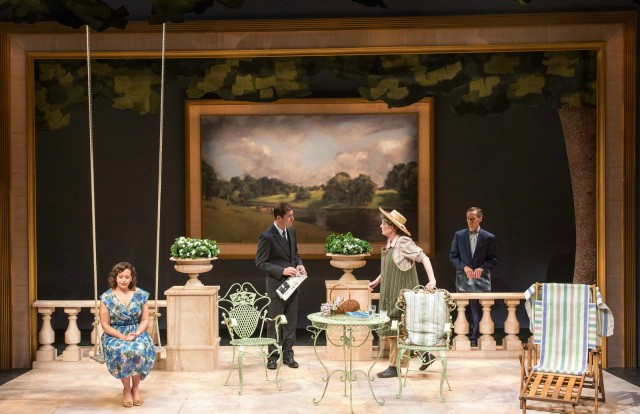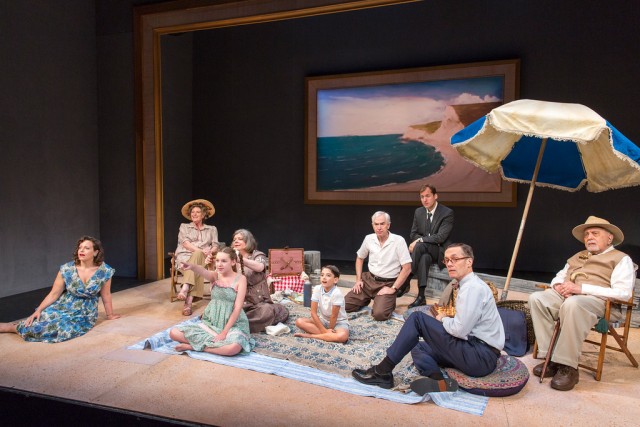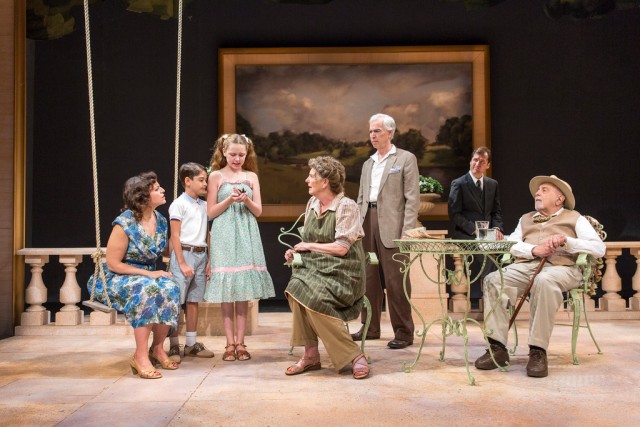
N. C. Hunter’s A DAY BY THE SEA begins and ends in a family garden (photo © 2016 Richard Termine)
The Beckett Theatre at Theatre Row
410 West 42nd St. between Ninth & Tenth Aves.
Tuesday – Sunday through October 30, $57.50
minttheater.org
www.theatrerow.org
In a previously unpublished author’s note printed in the program for the Mint Theater’s first-ever New York revival of N. C. Hunter’s A Day by the Sea, the playwright discusses middle age, explaining, “It is late, but it is not too late. There is still time, at forty, to do what is still undone. To succeed, to change one’s mind, to shape one’s life anew — there is still time, but there is not very much. The mistakes from which one can recover in youth cannot be made now, truths can no longer be evaded, decisions no longer postponed.” He might have been referring to the characters in the play, but it could just as well have been about this nearly three-hour production itself, directed by Austin Pendleton at the Mint’s new home at the Beckett Theatre at Theatre Row. The first act is dreadfully dull, flat and lifeless, as Hunter’s Chekhovian story about lost opportunities searches for meaning, having trouble as it goes from its own infancy through adolescence and into adulthood. But it fortunately finds itself in the wonderful second and third acts, discovering its purpose in middle age, proving that the mistakes of youth can be overcome and that there is indeed still time left to do what is still undone. A Day by the Sea takes place in Dorset in 1953, as a once-prominent postcolonial family attempts to hang on despite growing problems as the changing world passes it by. Prodigal son Julian Anson (Julian Elfer), a classic stiff-upper-lip Brit who has traveled around the world working for the Foreign Office, has returned home briefly, but he’s not particularly happy about it. His widowed mother, Laura (Jill Tanner), has planned a picnic at the beach, but Julian is more concerned with international politics and a visit by his boss, Humphrey Caldwell (Sean Gormley). “A great character, your mother,” family solicitor William Gregson (Curzon Dobell) says. “Yes . . . I sometimes think she believes I selected my profession solely with the idea of annoying her. Every time I come home it’s the same story. For about ten minutes she seems pleased to see me, and after that she never stops making derogatory remarks about my work and interests,” Julian responds. “My mother, after all, is an educated adult citizen, and if such people are going to turn their backs on the contemporary scene, shuffle out of their responsibilities, content themselves with cultivating their gardens and then flaunt their own ignorance and indifference — what a prospect! What hope for the future!”

A picnic at the beach leads to discussions of age and what might have been in Mint Theater revival (photo © 2016 Richard Termine)
Serious-minded and judgmental, Julian is not happy that his childhood friend Frances Farrar (Katie Firth), whom his mother took in after her parents died, has been staying at the house with her two young children, Elinor (Kylie McVey) and Toby (Athan Sporek), who are cared for by their governess, Miss Mathieson (Polly McKie). Frances’s first husband was killed in the war, and her second husband recently committed suicide, so Julian, who perhaps was at one time destined to marry Frances himself, displays outward disgust at what he considers scandalous behavior. Also at the estate are David Anson (George Morfogen), Laura’s elderly and infirm brother-in-law, who does a lot of sleeping, and his doctor, Farley (Philip Goodwin), who does a lot of drinking. The first act, in the garden, is just plain dreary, but as the action moves to a seaside picnic for the second act (the lovely sets, a Mint tradition, are by Charles Morgan), things pick up dramatically, as the characters become better developed, the narrative hits its stride, and the actors evolve into their roles, like young adults adapting and adjusting to a more grown-up life.

A dysfunctional family explores its past, present, and future in A DAY BY THE SEA (photo © 2016 Richard Termine)
The compelling third act brings everything full circle, returning to the garden, where several of the characters must face their demons head-on. By now they all feel like old friends we have watched mature, with their unique quirks, and the set makes more sense, an outer frame within another frame, with a painting on the back wall in the same frame, as if we can now see and understand all of the details in this fascinating portrait. A Day by the Sea premiered in 1953 in London with Sir Ralph Richardson, Irene Worth, Sir Lewis Casson, Dame Sybil Thorndike, and Sir John Gielgud, who also directed the show; it made its Broadway debut two years later with Hume Cronyn and Jessica Tandy, directed by Sir Cedric Hardwicke, and inexplicably hasn’t been seen again until now. The Mint, which specializes in finding old plays that time has seemingly forgot, previously revived Hunter’s A Picture of Autumn in 2013, with Firth, Morfogen, and Tanner among the cast. The always delightful Morfogen first worked with Pendleton in 1960 and was the star of Pendleton’s 1995 play for the Mint, Uncle Bob, which was written specifically for the actor. “Does something happen soon? It’s pretty dull, this,” Morfogen says as David in the first act. Despite that slow start and the overtly Chekhovian familiarity of the story, A Day by the Sea grows into yet another triumph for this splendid company, which is settling in nicely in its new surroundings.